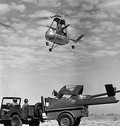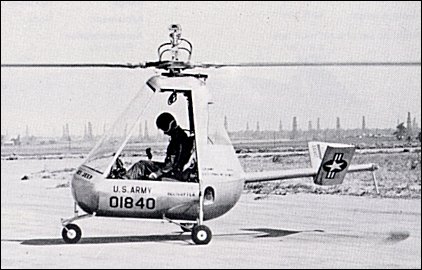|
|
The design of the Model XA-8 single-seat lightweight helicopter was undertaken in 1951 with the sponsorship of both the Army Transportation Corps and the USAF. The Army specification to which American Helicopter had responded in 1950 had called for a light, collapsible machine which could be used as both a light observation craft and as an air-droppable rescue vehicle for downed aircrew. American Helicopter was awarded a development contract in June 1951, and the first of an eventual five XH-26s flew for the first time almost exactly one year later.
The XH-26 was designed from the beginning to be both collapsible and air-droppable and its construction and diminutive size reflected both requirements. Only twelve feet long and just six feet tall, the helicopter could be transported in a five foot by five foot by fourteen foot container and could be unpacked and assembled by two men in less than thirty minutes. The machine's fuselage was built primarily of aluminum and fiberglas and featured an extensively glazed, pyramid-shaped cockpit. The XH-26 was powered by two pulse-jet engines, one fixed to the tip of each main rotor blade, and could burn virtually any type of fuel.
The Army and Air Force jointly evaluated the five XH-26 prototypes from 1952 to 1954. The machines were found to be robust in construction and relatively simple to operate, but neither service procured the type in quantity. S.Harding "U.S.Army Aircraft since 1947", 1990
 |
American Helicopter H-26
|
| Technical data for American Helicopter H-26
Crew: 1,
engine: 2 x American Helicopter XPJ49-AH-3 pulse-jets, rated at 16.2kg,
main rotor diameter: 8.23m,
fuselage length: 3.73m,
height: 1.88m,
take-off weight: 320kg,
empty weight: 135kg,
max speed: 130km/h,
cruising speed: 110km/h,
service ceiling: 2280m,
range: 160km
|
Warning: mysqli_connect(): php_network_getaddresses: getaddrinfo for mysql5.zone.ee failed: Name or service not known in /data03/virt15346/domeenid/www.aviastar.org/htdocs/helicopters_eng/american_h-26.php on line 84
Fatal error: Uncaught mysqli_sql_exception: php_network_getaddresses: getaddrinfo for mysql5.zone.ee failed: Name or service not known in /data03/virt15346/domeenid/www.aviastar.org/htdocs/helicopters_eng/american_h-26.php:84
Stack trace:
#0 /data03/virt15346/domeenid/www.aviastar.org/htdocs/helicopters_eng/american_h-26.php(84): mysqli_connect('mysql5.zone.ee', 'd14657sa18989', Object(SensitiveParameterValue))
#1 {main}
thrown in /data03/virt15346/domeenid/www.aviastar.org/htdocs/helicopters_eng/american_h-26.php on line 84
|





